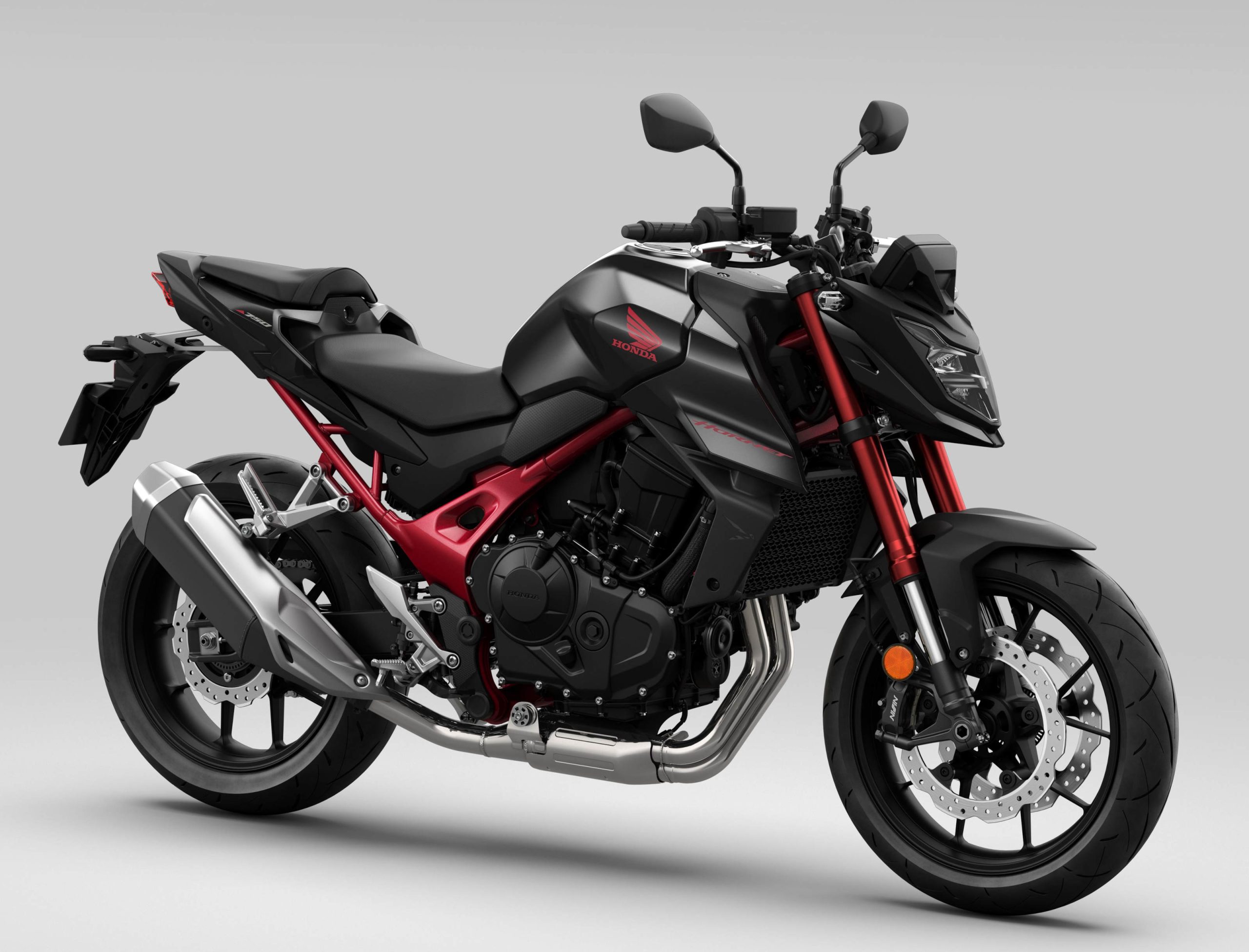
The much anticipated Honda CB750 Hornet was unveiled in Europe earlier today, along with an official announcement of the new naked’s details and specifications. All of those are below, but let’s hit the highlights before taking you to the press information.
Yes, this is a thoroughly modern motorcycle designed to beat the competition on both performance and price. Unfortunately, the bike has been announced for Europe without any indication of U.S. availability.
The 755cc parallel-twin engine features a 270˚ crank and puts out a claimed 92 horsepower and 55 foot/pounds of torque in a package that weighs a svelte 418 pounds wet (with the 4 gallon fuel tank full).
Built to a price (more about that later) the suspension is largely non-adjustable (only spring preload on the rear shock), although there are several electronic aids (described in the press release).
This bike should be extremely nimble, in addition to putting out roughly 10 more horsepower at the rear wheel than a Yamaha MT-07, for instance. Honda resisted the temptation to go with a 180 width rear tire, instead selecting a more nimble-handling 160. 296mm front brake discs also aide steering quickness, while much of the competition uses larger, heavier discs up front. Up-to-date details include LED lights and a large, bright TFT instrument display.
Without U.S. availability being discussed by the manufacturer, we are left to guess at pricing should this bike come to the U.S. market. Converting European currency values, however, brings some excellent news with an equivalent price of less than $8,000 U.S.
Here is the press information pulled from the Honda UK media site:
Press release date: 4th October 2022
New Model: Honda’s brand-new Hornet reveals its sting. Carrying zero excess mass, class-leading power-to-weight ratio is delivered by a 67.5kW and 75Nm engine driving a 190kg package. The all-new, eight-valve parallel twin-cylinder unit delivers both top end buzz and heaps of mid-range usability, combining with a new ultra-lightweight frame for supremely agile side-to-side performance and instant, riotous acceleration. Throttle By Wire (TBW) serves up 3 riding modes and 3-level Honda Selectable Torque Control (HSTC) with integrated Wheelie Control, plus 3 levels of Engine Braking and Power delivery. The new frame wears full Showa suspension: 41mm Separate Fork Function Big Piston (SFF-BPTM) USD forks and rear shock working through Pro-Link. Dual, radial-mount four-piston calipers bite hard. The premium specification includes 5-inch colour TFT instrument display, with Honda Smartphone Voice Control (HSVC), full LED lighting, auto-indicator cancel and Emergency Stop Signal (ESS) technology. An A2 licence option will also be available.
Contents:
1 Introduction
2 Model overview
3 Key features
4 Accessories
5 Technical specifications
- Introduction
The original 1998 CB600F Hornet grew to be a hugely popular bike in Europe, for many reasons. Its compact, naked form was great around town and it had the engine power and handling ability to carve a section of corners with joyous enthusiasm. Different iterations of the Hornet took it in the direction of sports touring and – in the hands of Hornet Cup racers –an outright race bike, while a 2007 upgrade added extra RR-derived top-end power and much more aggressive style.
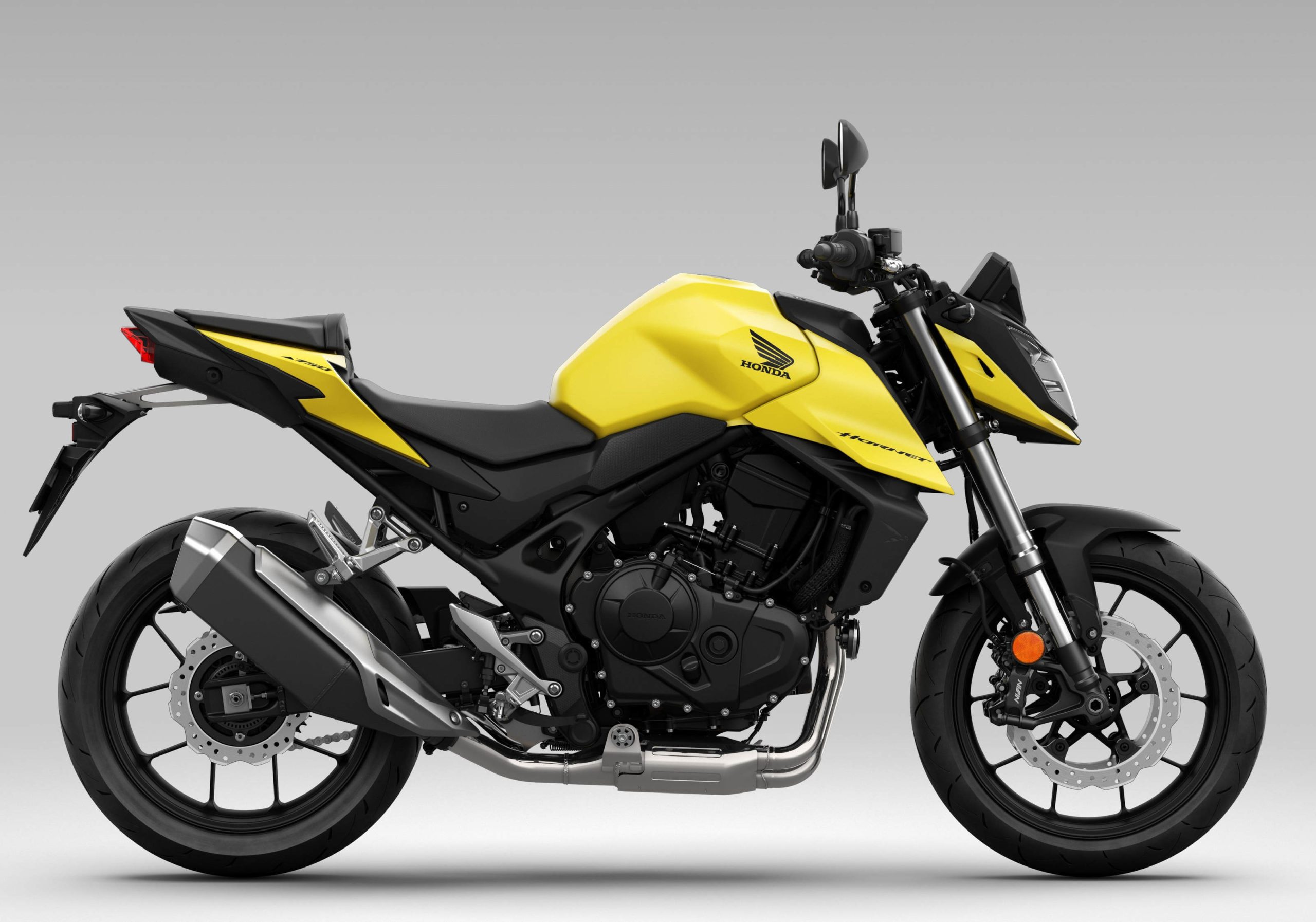
Every individual owner had a reason why their Hornet was so good, but two things remained constant throughout its life and development:
It was great fun to ride. And the fun came with an affordable price tag.
25 years is a long time and motorcycling has seen some major shifts since the first Hornet arrived. The naked bike segment continues to grow in both size and complexity, with many niches, and rider expectations have never been higher. A perfect time for a new Hornet to land – a bike for now and a whole new generation of riders. It has big tyre tracks to fill and serious competitors to contend with. None of which was lost on Honda’s development engineers.
This background has driven the creation of something quite special – a brand-new middleweight, the CB750 Hornet, which takes inspiration and direction from its ancestor but brings the celebrated Hornet brand right up to date. And packs it with a direct injection of excitement and pure-thrill adrenaline.
With styling led by the latest generation of creative minds in Honda’s Rome R&D facility, it’s been developed to attract younger riders looking for a serious move up. A totally new twin-cylinder engine hits hard with power and torque and features a comprehensive electronics package. High-quality Showa suspension works through a new, lightweight steel frame with high-spec running gear that allows the rider to exploit all the potential available. And minimalist look with uncompromising angles define a sharp, modern streetfighter style.
Honda have armed the CB750 Hornet with a class-leading power-to-weight ratio. And, to keep things simple, three words can be used to sum it up:
Fast, agile, fun.
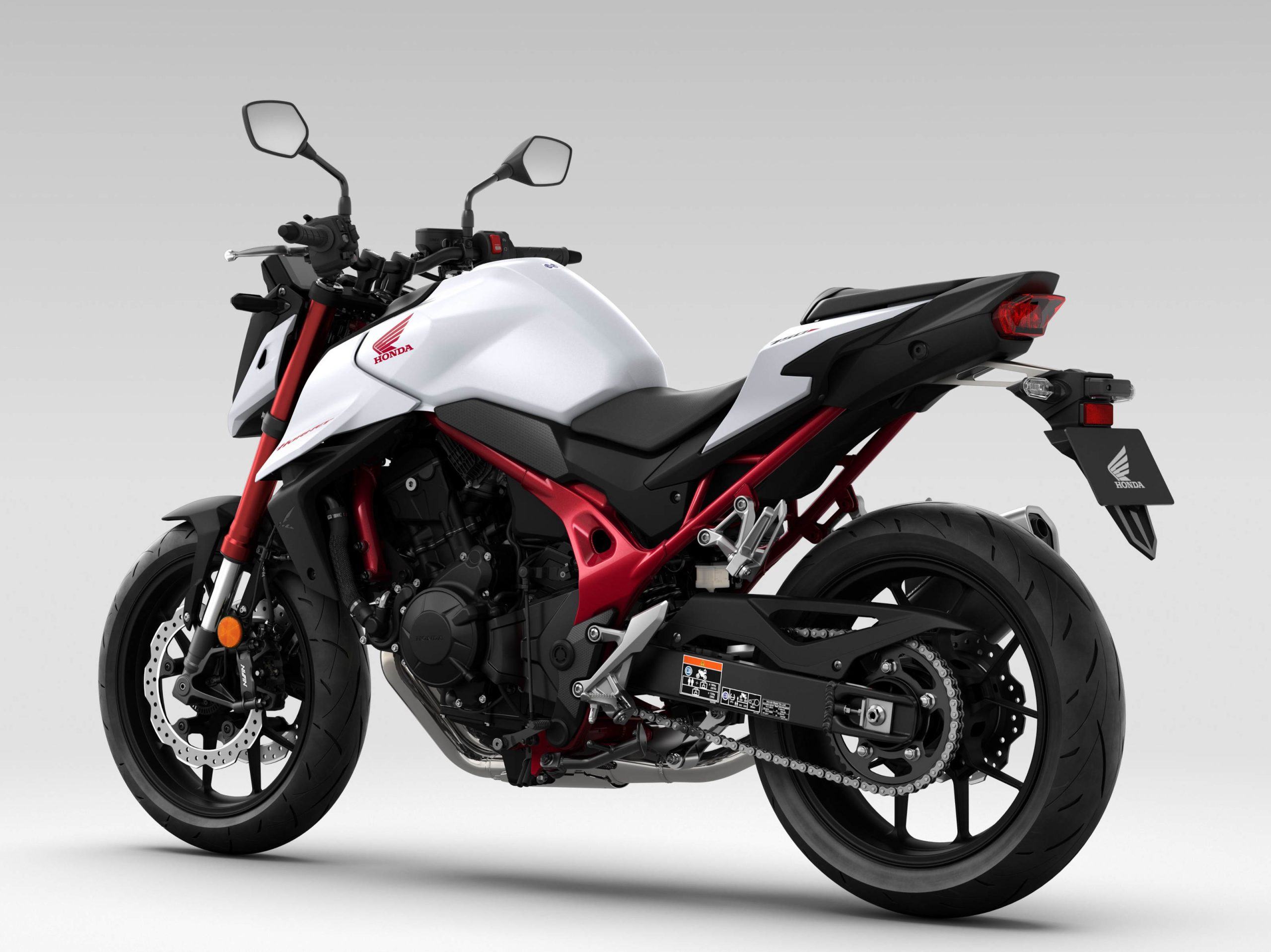
Mr, Fuyuki Hosokawa, Test Project Leader, Honda R&D, Japan:
“The Hornet has always been a very special motorcycle for Honda. Exciting, engaging performance has always been matched to lithe, agile handling.
Before starting this project, we thought long and hard about what kind of performance we wanted to give to the rider. We knew that it was essential to keep the classic Hornet top end power ‘hit’ and at the same time, as a new generation Hornet for modern times, we wanted the engine to have a really strong torquey feel and ‘throbbing’ sensation at low to mid rpm. Our aim has always been to match these to the lightest, most agile handling possible, to make every ride – even in town – as engaging and fulfilling as possible.
To get the kind of performance and lightweight handling we wanted, we knew we had to develop an all-new short-stroke twin-cylinder engine, with a 270° crankshaft. This would not only deliver that top-end rush, but also the sporty low-down torque, ideal for riding in urban environments and powering out of corners on the open road.
For us, the Hornet has always been the ultimate representation of the streetfighter concept and this new Hornet, proudly carries on this tradition.”
Mr. Giovanni Dovis, Lead Styling Designer, Honda R&D Rome:
“Honda’s design philosophy is to create something pure and functional in an uncomplicated way – models which are both beautifully simple and emotionally appealing. Our strap line to guide the form of the new Hornet was ‘Sensual Dynamism.’ It had to be a straightforward streetfighter design – just like the original – but we wanted much more aggressive angles and proportions. The silhouette and sinuous muscularity of a cheetah at full speed inspired us with its potency, driven by the obvious power of the new engine.
The look of the Hornet promises agility, dynamism and light weight thanks to its slim proportions, pointy tail section and super-sharp lines. It creates a new compactly proportioned look and has hallmarks of tension and aggression from front to back, outlining the Hornet’s true sporting purpose.
And we wanted this bike to stand out in another way: the metallic red frame and matching anodised forks are vibrant counterpoint to the coolness of the White or Black paint options. And, of course, we had to pay homage to its heritage, with the unique Mat Goldfinch Yellow.”
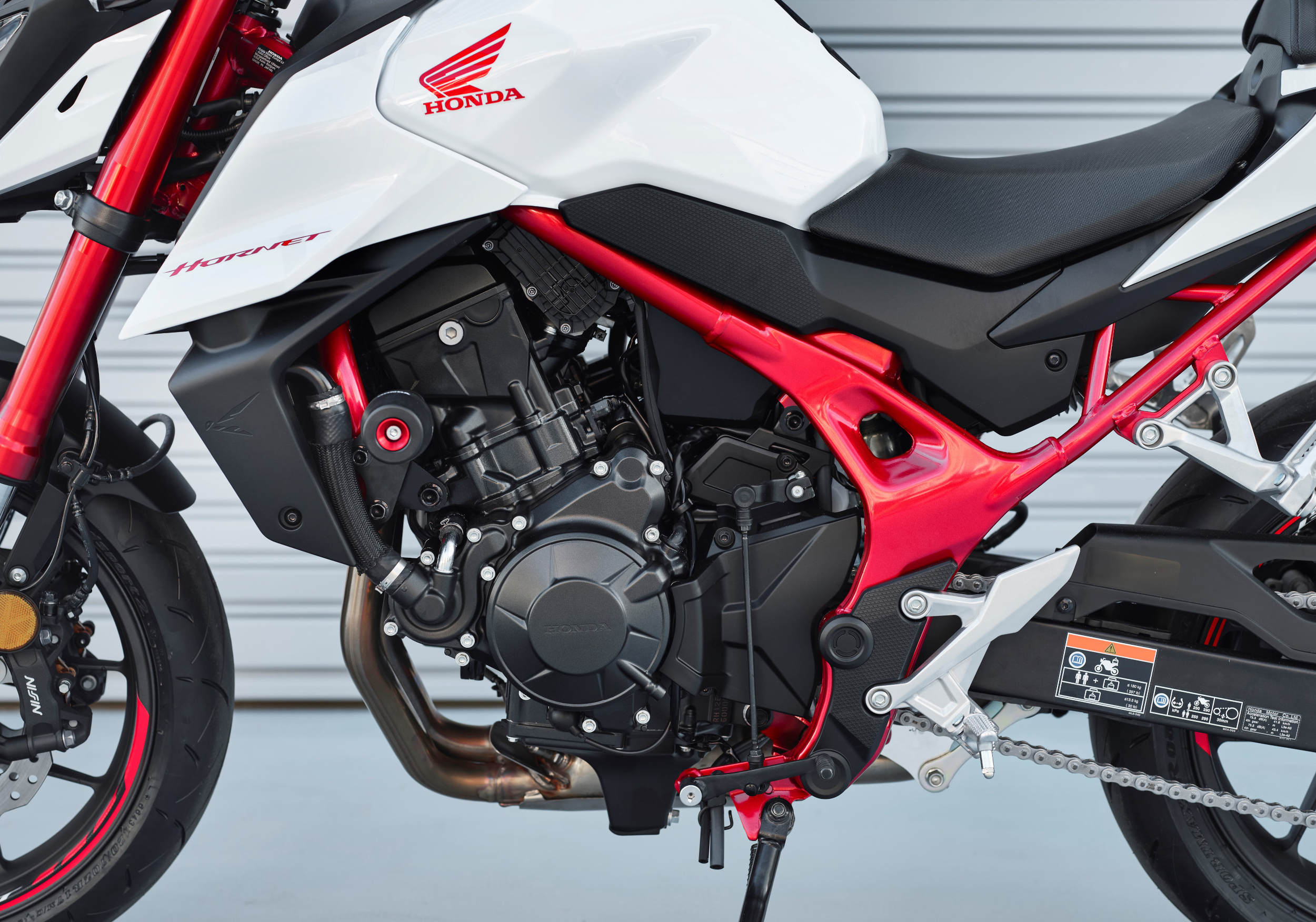
- Model Overview
The Hornet’s brand-new engine packs a great deal of Honda’s engineering prowess into a small space. Headline numbers: 755cc parallel twin-cylinder, 67.5kW peak power and 75Nm torque. With wet weight of 190kg it has a class-leading power-to-weight ratio of 0.36kW per kg / 2.81kg per kW.
Compact, competition CRF-derived Unicam eight-valve cylinder heads employ downdraft air intakes and a Vortex Flow Duct to ensure optimal combustion. A 270° crank delivers feel and character; the primary drive doubles as balance shaft while an assist/slipper clutch manages a six-speed gearbox. Electronic rider aids thanks to Throttle By Wire (TBW) include 3 riding modes (plus USER mode), 3-level Honda Selectable Torque Control (HSTC), Wheelie Control with 3-level Engine Power and Engine Braking adjustment.
To maximise the new engine’s potential, it’s housed in a totally new steel diamond frame, which is extremely light weight thanks to optimisation of wall/pipe thickness and stiffness. For optimal agility and rider feedback, suspension is top quality: Showa 41mm SFF-BPTM USD forks and rear shock operating through Pro-Link. Dual four-piston, radial-mount calipers stop hard while the tyres are sized to provide perfect levels of grip and agility – a 120-section front matched to 160 rear.
The rich specification list is headlined by a 5-inch TFT colour display which supplies vivid information delivery and management of all systems, as well as the connectivity of Honda Smartphone Voice Control system for both Android and IOS devices. All lighting is LED; the indicators auto-cancel and also include Emergency Stop System (ESS).
A range of accessories, including a quickshifter, soft luggage, engine protectors and cosmetic enhancements are ready to go (see full list below: 4. Accessories).
The 23YM CB750 Hornet will be available in the following colour options:
Pearl Glare White with Metallic Red Flame frame and anodised Red forks
Graphite Black with Metallic Red Flame frame and anodised Red forks
Matte Iridium Gray Metallic
Mat Goldfinch Yellow
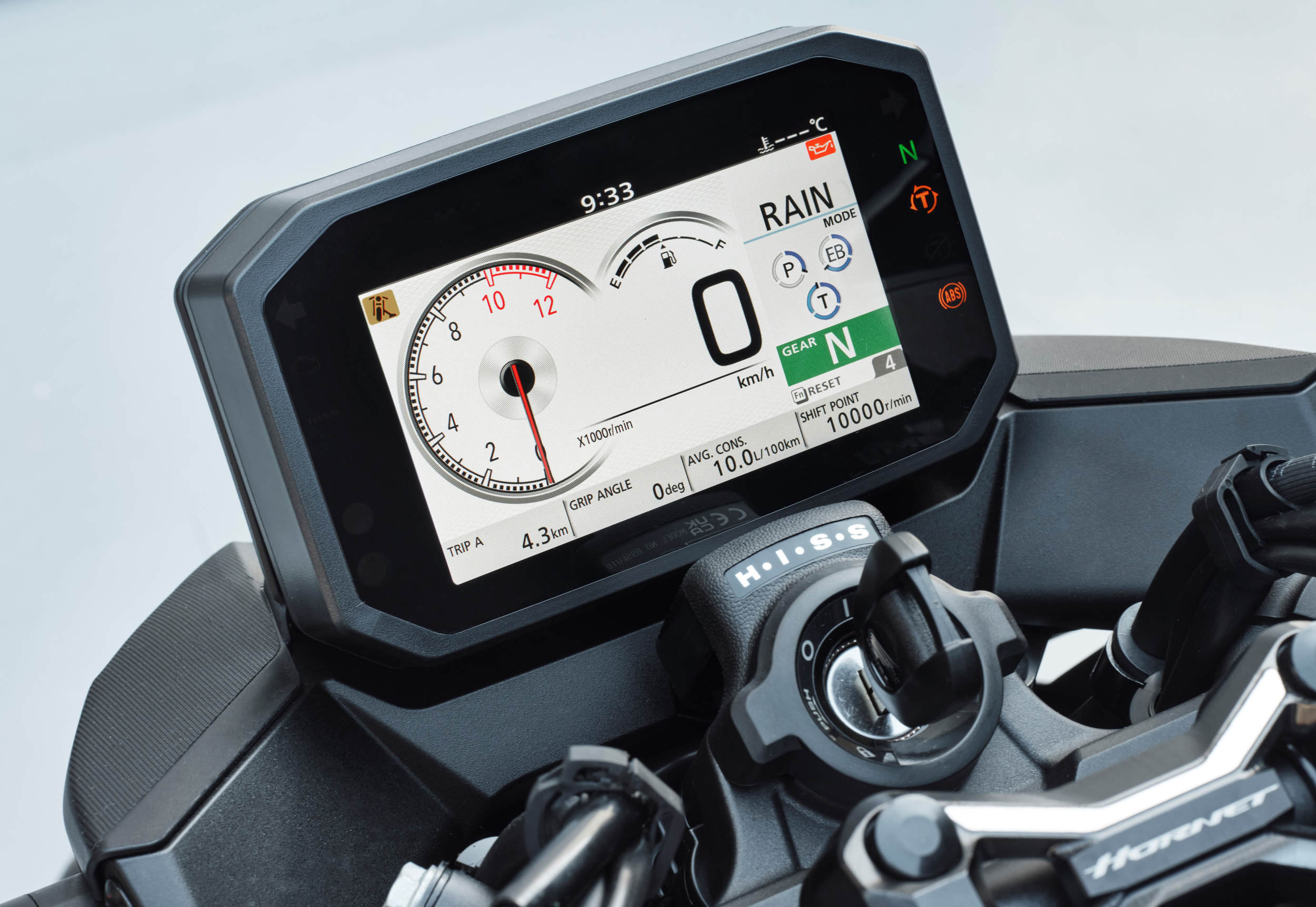
- Key Features
3.1 Engine
- All new 755cc parallel twin 8 valve unicam engine
- Max power – 67.5kW @ 9,500rpm
- Max torque – 75Nm at 7,250rpm
- 270° crankshaft and uneven firing order for maximum engine character
- Patented Vortex Air Flow ducts for optimum airflow
- Assist /slipper clutch offers light lever feel and manages rear wheel hop on downshifts
- 23km/l fuel economy with a potential 340km tank range
The unveiling of a brand-new Honda engine is always a special moment. Presenting it as part of a brand new Hornet demonstrates the significance of the return of the iconic model name. Honda’s engineers have built a brand-new, parallel twin-cylinder powerplant packing hugely enjoyable punch to give the Hornet its performance edge. It’s designed for every rider to exploit to the maximum, with exhilarating peak power output, but also to deliver accessible low to mid-range usability – perfect for the less experienced, and a major boost to the enjoyment of everyday town riding.
755cc, with an 8-valve Unicam cylinder head it pumps out 67.5kW @ 9,500rpm with 75Nm torque @ 7,250rpm. Bore and stroke is set at 87 x 63.5mm with compression ratio of 11.0:1. Compact and lightweight (and a configuration used by the MX competition-ready CRF450R) the Unicam head operates the 35.5mm inlet valves via cam, and the 29mm exhaust by rocker arms. Inlet lift is 9.3mm, exhaust 8.2mm.
For razor-sharp pick-up and throttle response patented Vortex Flow Ducts create a more uniform distribution from the side scoops into the airbox, which then feeds downdraft intakes and 46mm diameter throttle bodies.
The 270° crank and uneven firing order create a characterful, twin-cylinder pulse feeling. To make the engine as tightly wrapped as possible there’s no balancer drive gear; the primary drive gear doubles up duties and also spins the balance shaft. The water pump is tucked away inside the lefthand engine cover and there’s no need for a water-cooled oil-cooler. The cylinders also use a Ni-SiC (Nickel-Silicon Carbide) coating, as also used in the CBR1000RR-R Fireblade and CRF450R.
An assist/slipper clutch – with oblique layout disc segments – offers light lever feel, eases up shifts and manages rear wheel hop under hard braking and rapid down changes.
Fuel consumption of 23km/l (WMTC mode) offers a potential range of over 340km from the 15.2L fuel tank. A 35kW, A2 licence option will also be available.

3.2 Engine Electronics
- Three default rider modes; RAIN, STANDARD and SPORT
- Three levels of Engine Power, Engine Brake and HSTC with integrated Wheelie Control
- USER customisation option between the three levels
Throttle By Wire engine control offers three default riding modes, adjusting the engine’s delivery and feel to suit conditions and the rider’s intent; they’re easily switched and managed between the left handlebar mode switch and TFT screen.
There are 3 levels of Engine Power (EP), Engine Brake (EB) and Honda Selectable Torque Control (HSTC) with integrated Wheelie Control available; HSTC can also be switched off. The riding modes offer different combinations of each parameter.
SPORT uses level 3 EP and level 1 EB and HSTC to deliver maximum performance with minimum intervention.
STANDARD mode is a mid-way setting that uses level 2 setting for EP, EB and HSTC.
RAIN mode employs the lowest EP setting, level 1, for the least aggressive power delivery with level 2 EB and 3 HSTC.
USER mode allows the rider to choose between the 3 settings for each parameter and save the setting for future use.
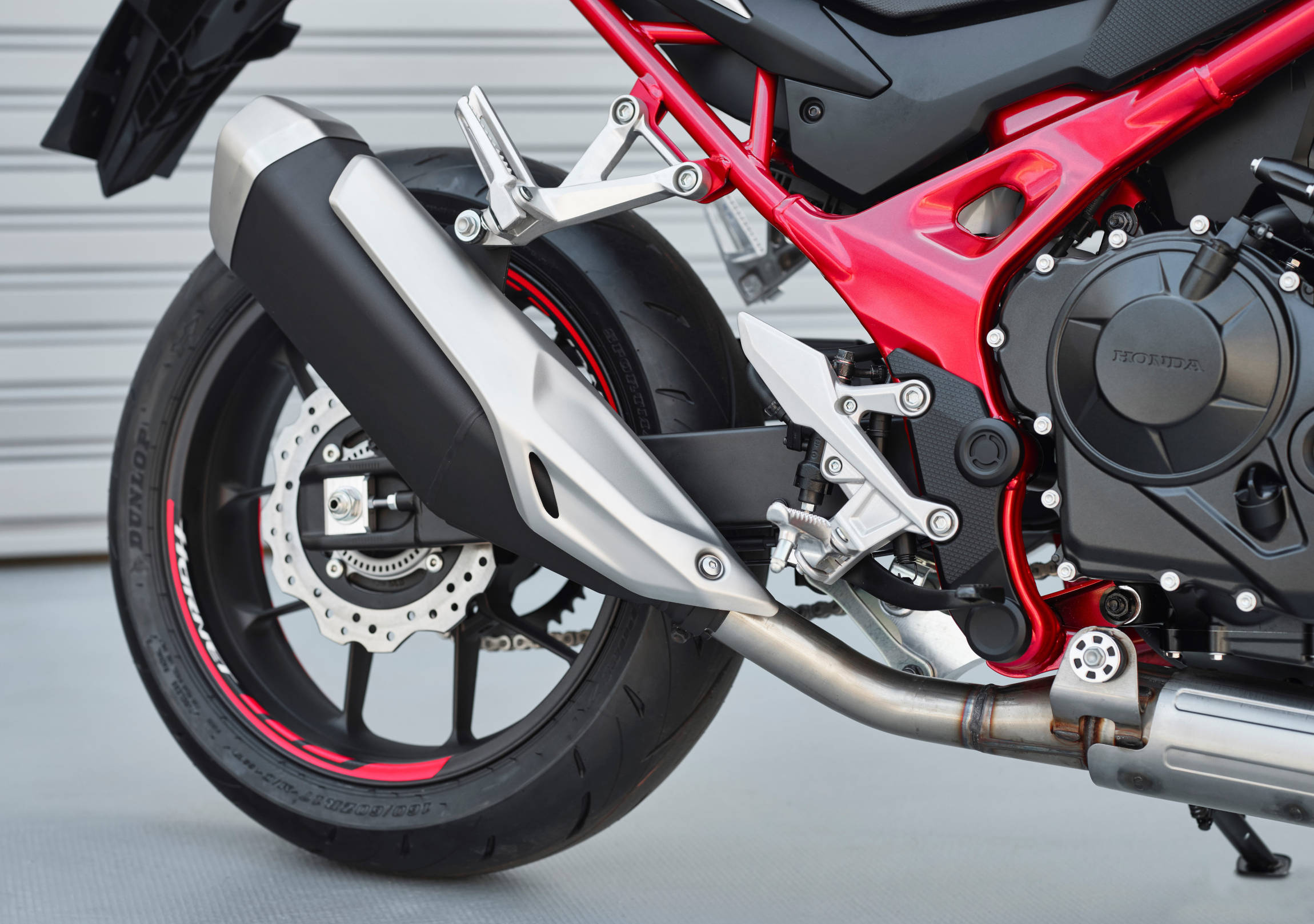
3.3 Styling & Equipment
- New style defines razor-sharp minimalism
- Upright riding position for natural control
- Customisable, 5-inch TFT display with shift-up indicator
- Honda Smartphone Voice Control system offers Android and IOS smartphone connectivity
- The rear indicators feature Emergency Stop Signal and auto cancel technology
Honda’s R&D designers in Rome looked, with respect, to Hornets of the past and went to work on a new, contemporary expression of technical beauty with the silhouette, lines and shaping in compact, elegant proportion.
The main signature of the Hornet is the fuel tank, which takes inspiration from the shape of a hornet’s wing. Everywhere you look, from the aggressively angled nose-fairing to the razor-sharp, minimal tail, there are hallmarks of tension and aggression, outlining true sporting intent.
Usability, for all riders, is also inherent to the design. Seat height is a very manageable 795mm and the riding position upright, with slightly rear-set footpegs for natural control and wide handlebars for leverage.
The instruments comprise a 5-inch, full colour high-visibility TFT screen, which offers four types of speed/rpm display – analogue or bar, according to rider preference – as well as fuel gauge/consumption, riding mode selection/engine parameters, gear selected and customisable shift-up point on the rev-counter. Management is via the screen and switchgear on the left handlebar.
Also incorporated into the interface is the Honda Smartphone Voice Control system, which links the rider to their Android while on the move and allows voice management of phone calls, messages, music and navigation. For the first time, several of the HSVCs will also be accessible on IOS smartphones. A helmet-mounted headset is needed, and the smartphone connects to the dash via Bluetooth; management of Honda Smartphone Voice control is also possible using buttons the left switchgear.
To simplify and miniaturise the entire electrical system the Hornet uses a Controller Area Network (CAN) alongside a Body Control Unit (BCU). The BCU is sited under the main seat and collectively processes control signals – from the ABS modulator, TFT screen and switch gear – that are not controlled by the ECU in the CAN system.
The rear indicators have an Emergency Stop Signal (ESS) function. At a minimum speed of 56km/h, with either brake working if negative acceleration of a minimum of 6.0m/s2 is detected, the hazard lights flash to warn other road users a hard stop is in process. At the same speed the threshold is reduced if ABS is activated, to a negative acceleration of a minimum 2.5m/s2.
They also auto-cancel; rather than using a simple timer, the system compares front and rear wheel speed difference and calculates when to cancel the indication relative to the situation.
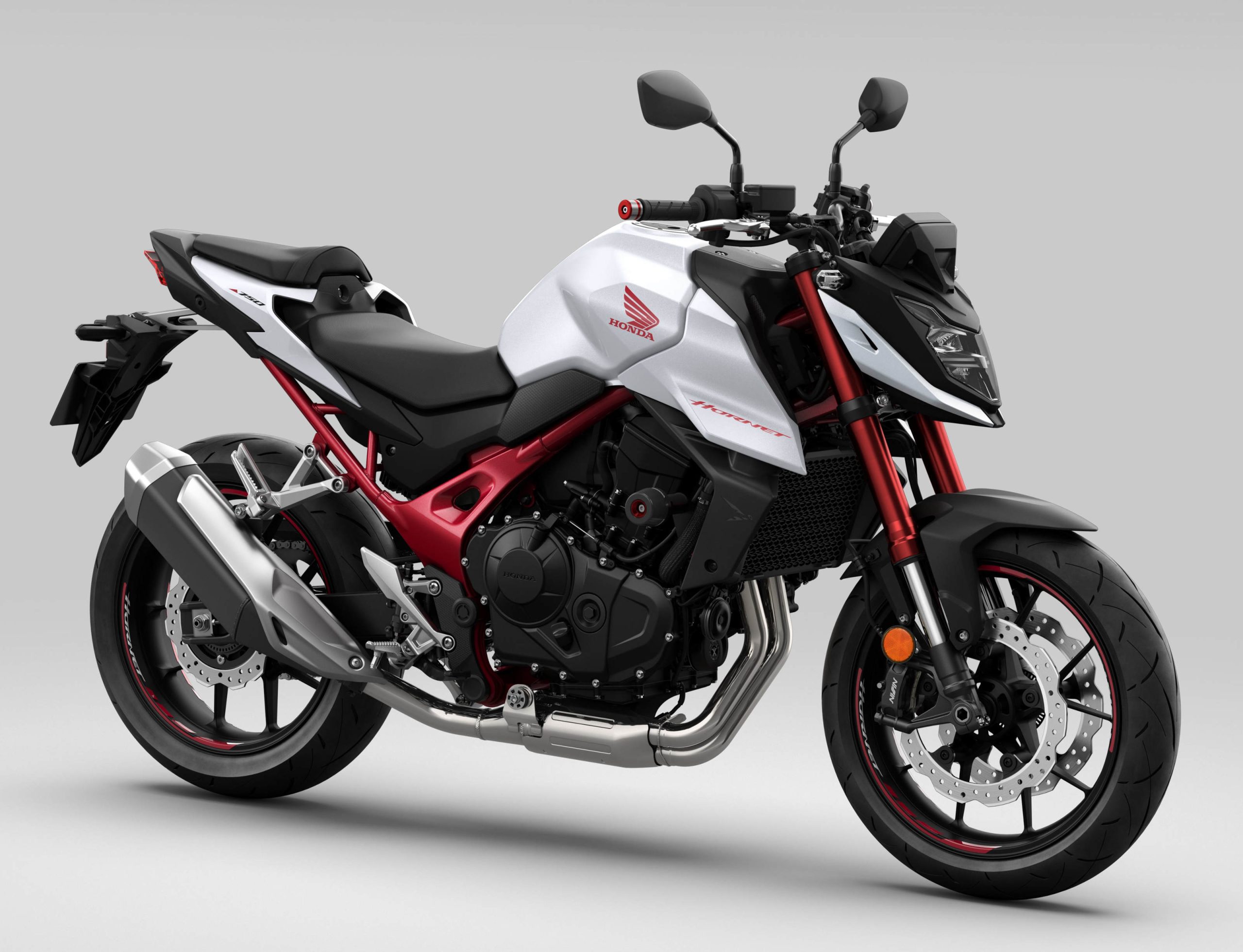
3.4 Chassis
The Hornet’s steel diamond frame is lightweight, at just 16.6kg (for comparison, the CB650R’s is 18.5kg). A major technological process of stiffener, main/down tube thinning, and pivot shape optimisation has produced a hugely strong platform, with rigidity balance to deliver feel and geometry set for agility – just what the engine needs.
Rake and trail are set at 25° and 99mm, with wheelbase of 1,420mm and kerb weight of 190kg.
With a view to heighten sports handling performance (especially braking from higher speeds) Showa 41mm Separate Function Fork Big Piston (SFF-BPTM) USD forks are clamped by Hornet-specific top and bottom yokes. With 130mm travel and by dividing the functions – Big Piston pressure separation damper in one leg, spring mechanism in the other – maximising both reaction over changes in road surface and the overall ride quality.
The rear shock absorber operates through the steel swingarm via Pro-Link and offers 150mm travel. Its design ensures excellent response and temperature management; it features 5-stage preload adjustment with spring rate and damping settings optimised to match the forks.
Dual front 296mm discs and Nissin radial-mount, four-piston calipers deliver impressive, fingertip stopping power, with excellent progressive feel through the lever. To further elevate handling and ride quality lightweight wheels use Y-shaped spokes. Front wheel width is 3.5inch wearing 120/70-ZR17 tyre, the rear 4.5inch with 160/60-ZR17 tyre.
- Accessories
A full range of accessories are available for the Hornet, ready for personalisation to an owner’s preference and use.
For aggressive sports riding, or more relaxed touring a quickshifter offers instant, full throttle upshifts and clutch less downshifts with auto blip function. The lever load sensitivity can be adjusted in 3 stages to suit preference.
The rear seat cowl adds single-seat sports appeal, while a stitched rider’s seat – a brand-new design finished in grey/black – exudes premium appeal and elevates comfort. Also new are the aluminium bar-end weights, handlebar upper clamp holder, fly screen, wheel stripes, rider footpegs and protective skid bungs.
Practicality has not been forgotten. A tank bag and seat bag provide soft-luggage convenience, while a new rear pannier design offers hard-luggage security. For rider comfort, heated grips are also available.
To make it easy for an owner there are 3 packs that group the accessories neatly together:
SPORT PACK
Quickshifter, fly screen, rear seat cowl and rider footpegs
STYLE PACK
Bar end weights, handlebar upper clamp holder, tank pad, wheel stripes and skid bungs.
TOURING PACK
Rear panniers, tank bag and seat bag.
- Technical specifications
| ENGINE | |
| Engine Type | Liquid-cooled OHC 4-stroke 8-valve Parallel Twin with 270° crank and uni-cam |
| Engine Displacement | 755cc |
| Bore x Stroke (mm) | 87mm x 63.5mm |
| Compression Ratio | 11.0:1 |
| Max. Power Output | 67.5kW @ 9,500rpm |
| Max. Torque | 75Nm @ 7,250rpm |
| Noise Level (dB) | Lwot – 77.5; Lurban – 73.5 |
| Max Speed | 205 km/h |
| Oil Capacity | 3.8L |
| Starter | Electric |
| FUEL SYSTEM | |
| Carburation | PGM-FI electronic injection |
| Fuel Tank Capacity | 15.2L |
| CO2 Emissions WMTC | 100 g/km |
| Fuel Consumption | 23km/l – 4.35l/100km |
| ELECTRICAL SYSTEM | |
| Battery Capacity | 12v 7.4Ah |
| DRIVETRAIN | |
| Clutch Type | Wet multiple, Assisted slipper clutch |
| Transmission Type | 6 speed Manual Transmission |
| Final Drive | Chain |
| FRAME | |
| Frame Type | Steel diamond |
| CHASSIS | |
| Dimensions (LxWxH) | 2,090mm x 780mm x 1,085mm |
| Wheelbase | 1,420mm |
| Caster Angle | 25˚ |
| Trail | 99mm |
| Seat Height | 795mm |
| Ground Clearance | 140mm |
| Kerb Weight | 190kg |
| Turning radius | 2.7m |
| SUSPENSION | |
| Suspension Front | Showa 41mm SFF-BPTMTM USD, 130mm travel |
| Suspension Rear | Monoshock damper, Pro-Link swingarm, 150mm travel |
| WHEELS | |
| Wheels Front | 5Y-Spoke Cast Aluminium |
| Wheels Rear | 5Y-Spoke Cast Aluminium |
| Tyres Front | 120/70ZR-17 |
| Tyres Rear | 160/60ZR-17 |
| BRAKES | |
| ABS Type | 2 channel |
| Brakes Front | Dual 296mm x 4mm disc with Nissin radial mount 4 piston calipers |
| Brakes Rear | Single 240mm x 5mm disc with single piston caliper |
| INSTRUMENTS & ELECTRICS | |
| Instruments | TFT screen |
| Headlight | LED |
| Taillight | LED |
| Connectivity | HSVC |
| USB | Type C |
| Auto Winker Cancel | Yes |
| Security System | HISS |
| Additional Features | ESS, 4 Riding Modes |
All specifications are provisional and subject to change without notice
Please note that the figures provided are results obtained by Honda under standardised testing conditions prescribed by WMTC. Tests are conducted on a rolling road using a standard version of the vehicle with only one rider and no additional optional equipment. Actual fuel consumption may vary depending on how you ride, how you maintain your vehicle, weather, road conditions, tire pressure, installation of accessories, cargo, rider and passenger weight, and other factors.

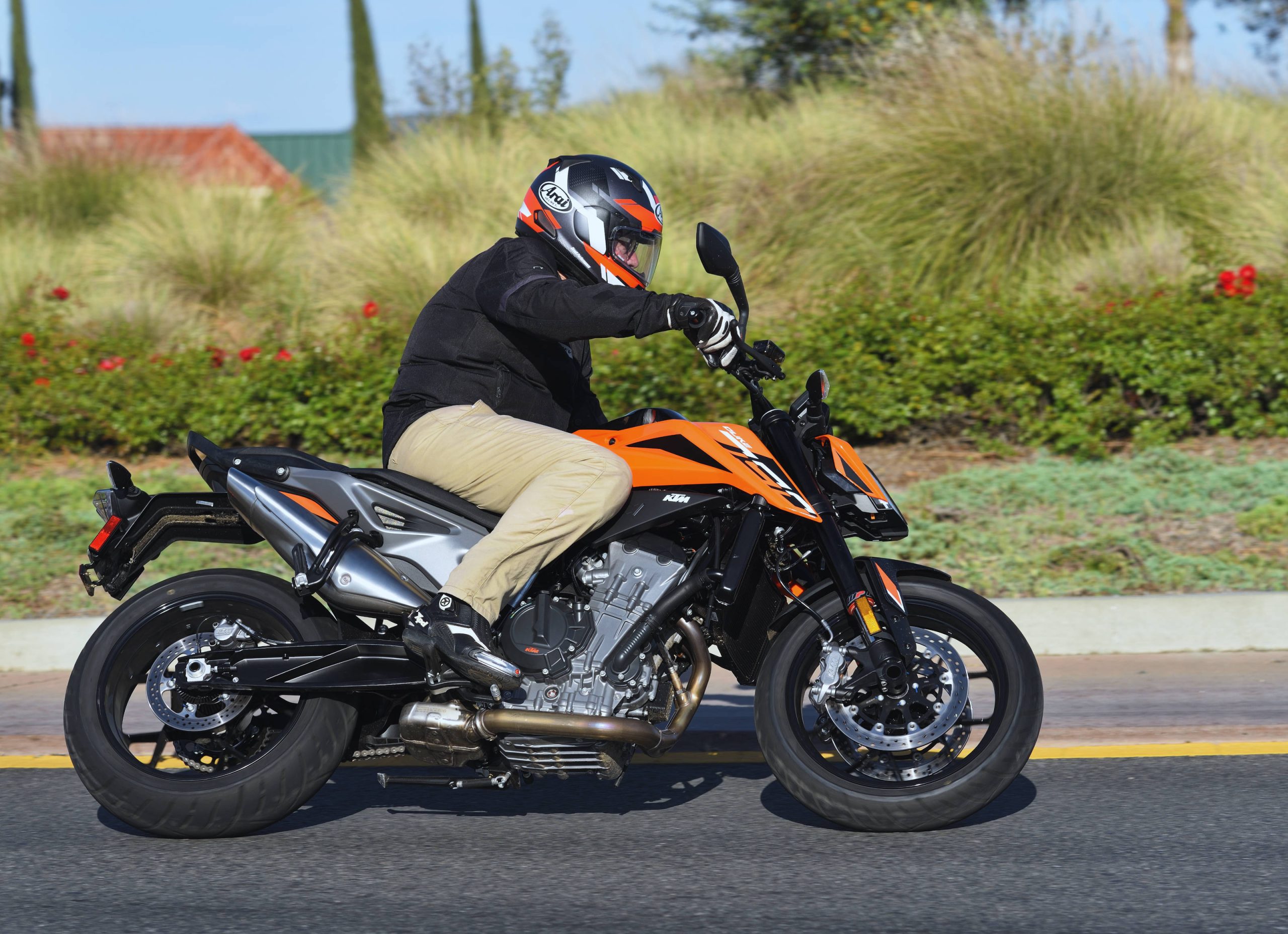
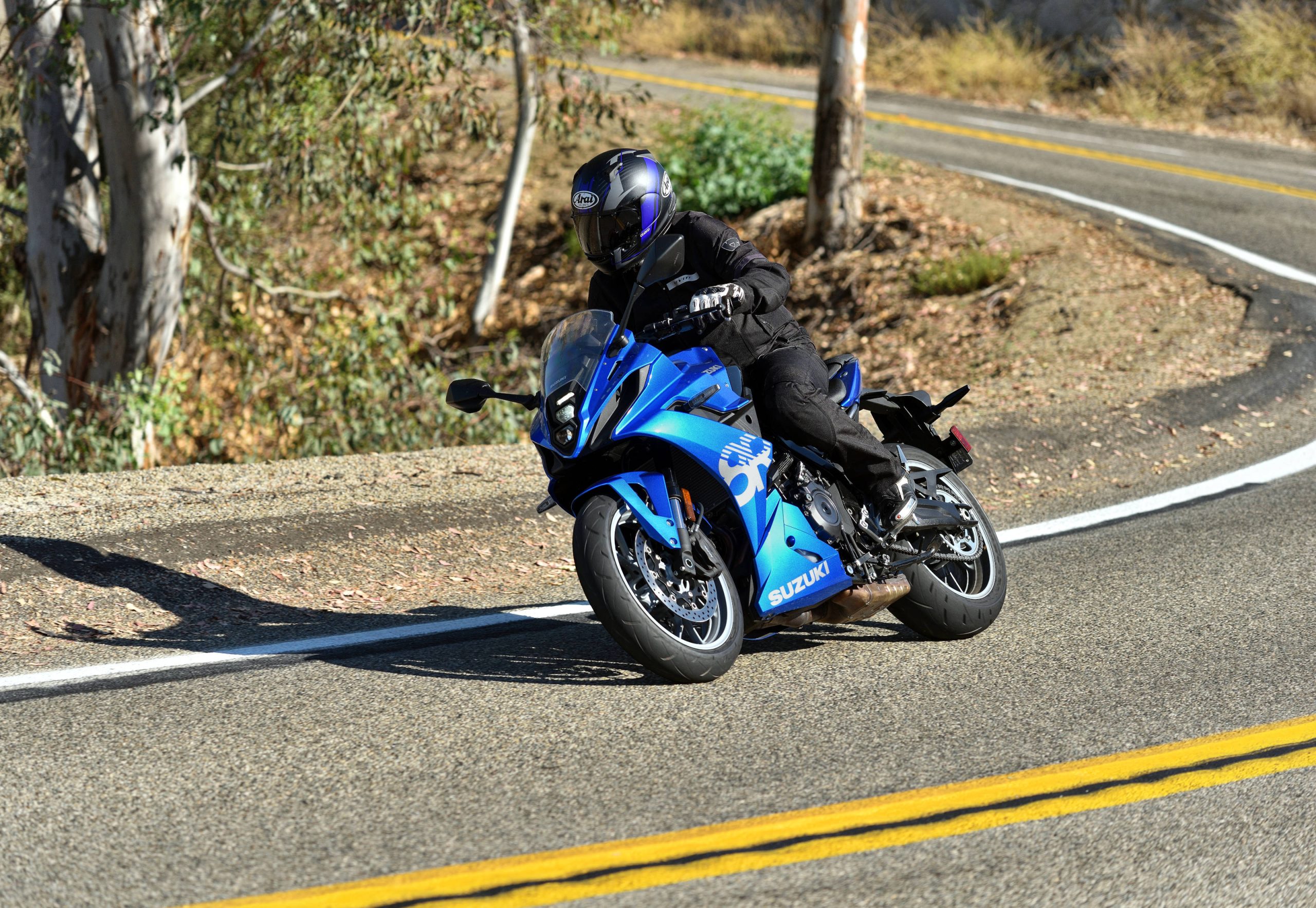
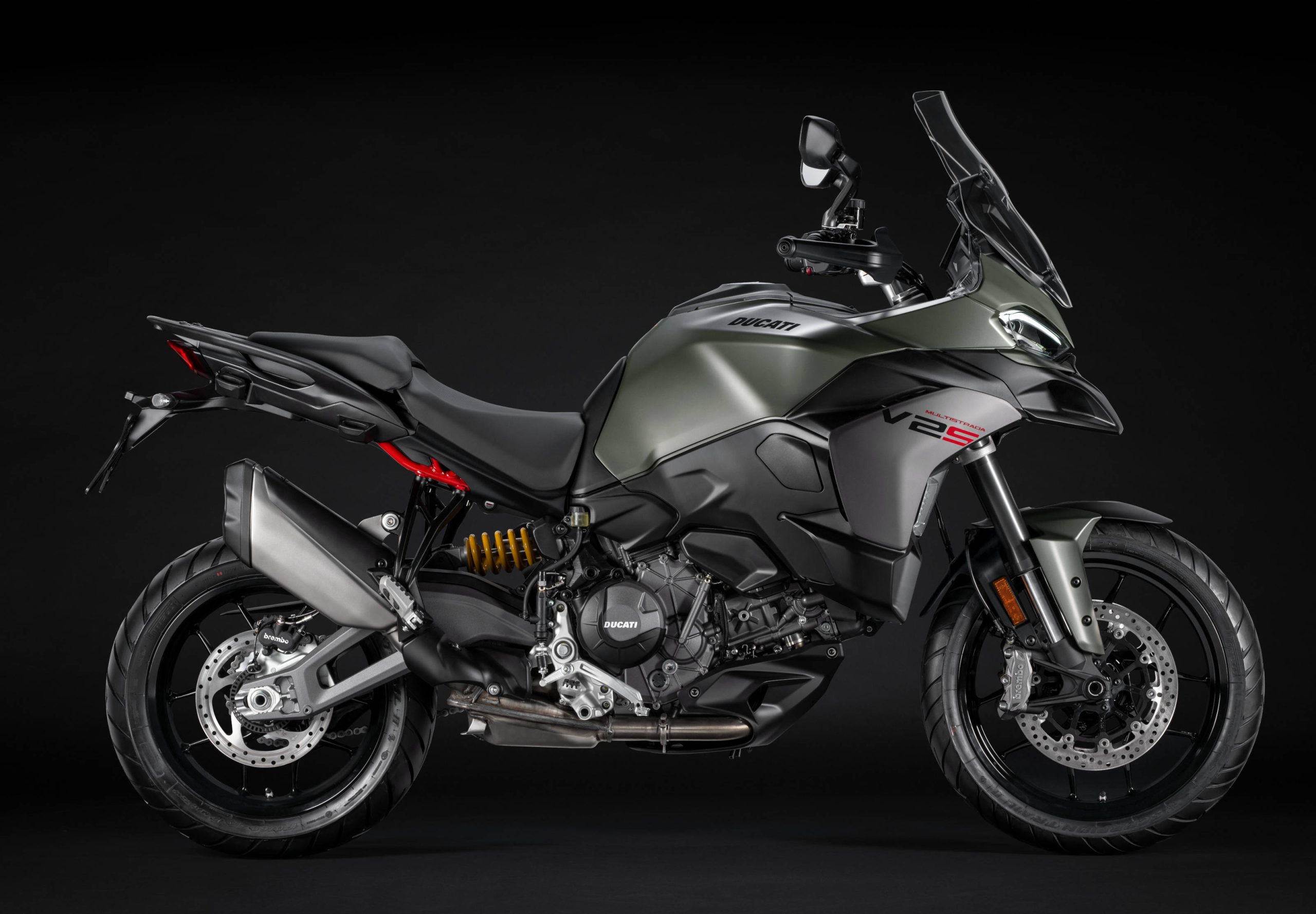
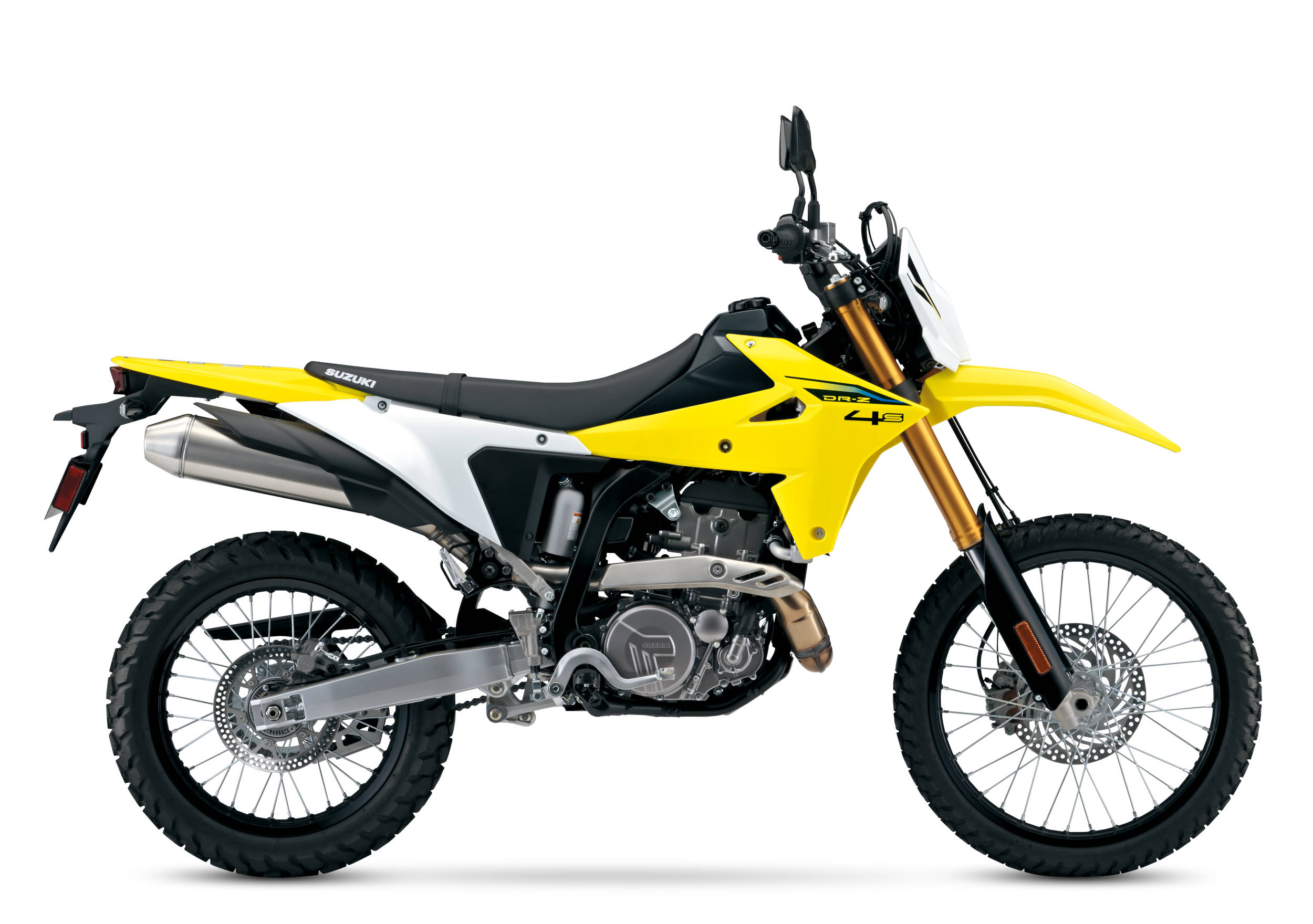
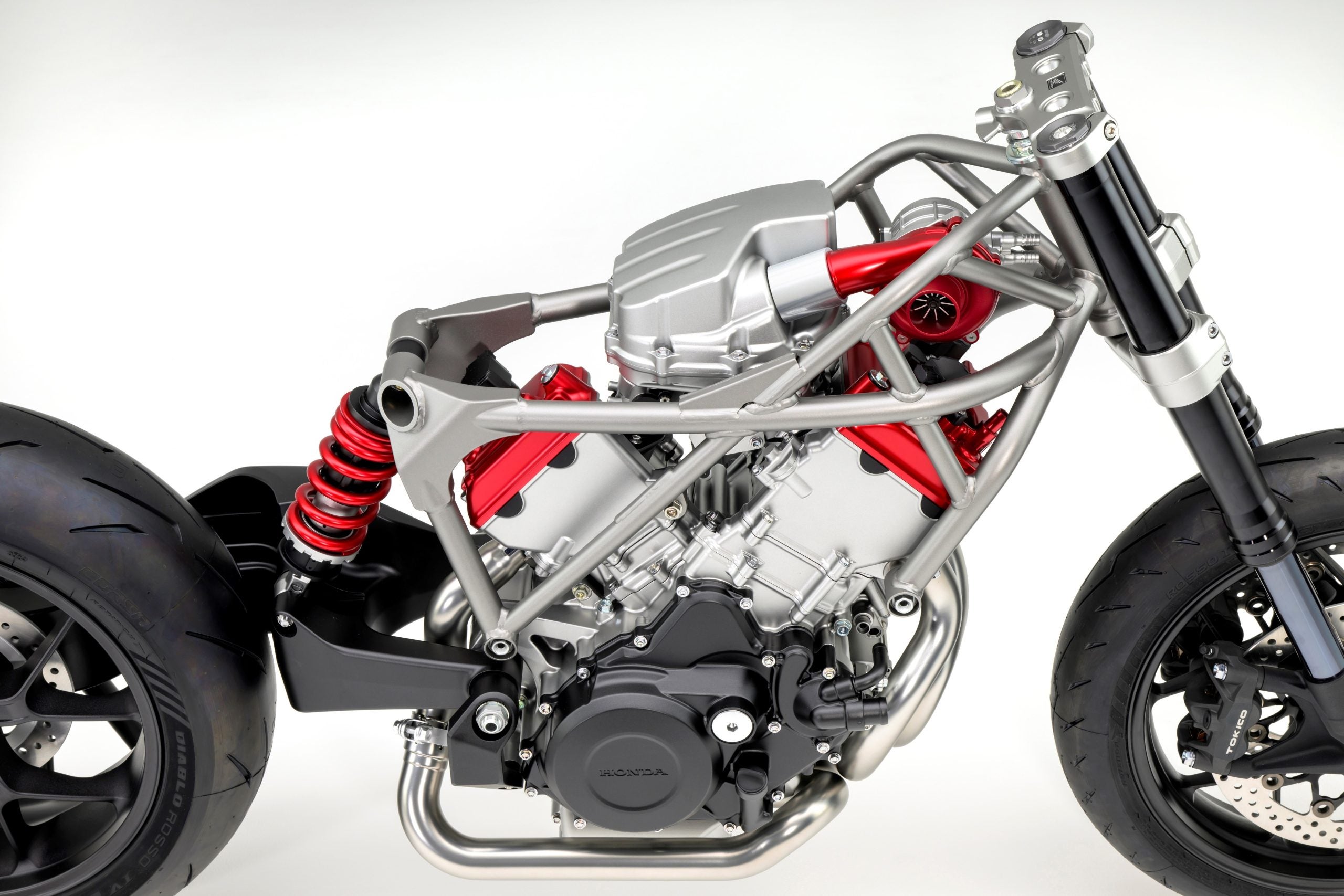
It looks like the CBR1000rr without the fairings and with a much uglier headlight. Having had a CB500 it gets cramped quickly for 5 10 riders. I like the 500 but it needed to be faster on the highway and it should be easier to add a windscreen that gets the wind off helmets. I like the old windscreens that had a curve missing in the middle to eliminate wind buffeting and which throws wind to the side and over one’s shoulders.
I absolutely had to get a Corbin seat. The stock one was good for ten miles and then felt like it was getting harder by the second.
Looks like a Chinese bike for sale on Amazon. Not that there is anything wrong with that!
The comments make it so clear why the manufacturers have an impossible task. Why don’t they just go out of business. People these days are hyper-critical obsessive over every detail and nuance. This bike has to split hairs because of this. A “little” hornet like (BUT NOT TOO MUCH). A level of HP, handling and features that satisfy the average buyer (IF SUCH A THING EXISTS ANYMORE). They know that every single facet of the bike will get ripped so they juggle and dangle (a few features for THESE people and a few features for THOSE people).
This is a nice bike, with “adequate” everything. AND IT SATISFIES NO ONE. Sorry, but I’m on Hondas side. The problem isn’t the bike. It’s the spoiled rotten, entitled public. I’ve owned bikes from every decade back to 1970. And as bikes became more capable and more feature laden, the buyers became exponentially picky to the point of absurdity. (And those same people will rip my sentiment). I like the majority of bikes produced today and all I need to do is find one that fits me ergonomically, is nimble, and I don’t need track power. I only agree with ONE SINGLE COMMON OPINION. The manufacturers went way overboard on the “mad bug” look and it has persisted way too long. I think this bike actually tones it down some, but it is an aesthetic that needs to go away with the exception of the specific track weapons the boy racers wet their pants over.
If all these fashionable and popular bikes had fewer ‘features’ and more practical design elements there would be less to criticize. You are severely correct about the stupid intimidation bug look.
IMO
Nice looking all-round package, I’d take it in white.
Honda had a brand icon in “CB750”. They just trashed it.
Styled in Italy by an Italian, they lifted the red frame from other Italian makes, and while I’ll quite readily admit I’m backing into being an old codger, was it REALLY necessary to make one more Japanese bike with an insect vibe?
No doubt a great bike and reliable as all Hondas, but gee whiz, an Italian came up with THAT look ?
Looks about like what they were doing before to me.
Boring, maybe. Copying? Meh.
https://d3avoj45mekucs.cloudfront.net/astrogempak/media/drebar/2019/dscf6366_batch.jpg
Is Yamaha the first to use 270 or the first to let the marketing department get wind of it?
Yamaha first used the 270 degree crank on the 1995 TRX850 and the second generation TDM850, both not sold in the US market.
The TDM850 was sold in the US.
Hm.
(listdrop)
https://motofomo.com/motorcycles-270-degree-crank/#motorcycles-with-parallel-twin-270degree-crankshafts–a-complete-list
I think that it is a nice all around bike.
I worked at the dealer level for 30 years, and every customer is different. You cant make one bike that everyone likes. As the years go by, I’ve tried to keep up with all that is happening in the new bikes every year, although its difficult at times. Bikes built to a price point, always have cost saving parts. Then there are comments like, “it has too much space between the rear wheel and the seat”, or “I dont like the beak”, or “the tank has seams”, and the most often of all, “I dont like the way it looks”. This new model from Honda, shows that they have done the hard work. I do think Honda has created a couple bikes “the bike no one asked for”, this isnt it. I liked my GSF1250 but totaled it hitting a deer. This seems to be its little brother. I dont think many read all the boxes of just what this bike does have. I like it. Its new. I’m sure its better, than what most think it is, or will be. Cant wait to ride one.
Though I’m still waiting to see if Suzuki does a GSX-S750GT, I would definitely give this bike attention if it were to show up with an upper fairing, adjustable screen and cruise control.
No one’s mentioning those Moto GP winglets. In white, it’s not bad. I might give it a look.
Being a Honda guy its ok but it does seem to lack something. Maybe seeing it in person would change that. But just going by the pics shown and the videos I’ve seen, it just doesn’t do it for me. If I were to buy one though, it would be the black or white version.
I like it ..! 90bhp is plenty of output for most real-world situations.
I had a SV650 with 160 rear tyre, I didn’t ever feel it was under-tyred or lacked grip. I have a Triumph Tiger Sport 660 with 180 rear, which is more fashion statement than necessity – although not something I think about much 😉
The Hornet looks good, and is the right price. When the time comes to change the TTS, I’ll definitely be looking at the Hornet.
I’m hoping for an NT version after the Trans Alp is announced.
Looking at the weld, the swingarm is not steel. Also, the general shape is like Al. Must be a misprint.
The entire design reeks of “efficiency” and cost-cutting. It’s like the 90’s revisited only cheapened. If this is the future of motorcycling, I’m out.
If you choose to see it that way then I’m sorry for you. It isn’t as though this bike is wrapped in plastic, pretending to be something it isn’t. It’s what the Hornet always was- a value oriented fun bike to ride for people who don’t care who won last week’s GP or what the other bike’s spec sheet says.
a 400-four was cheap too, but it was a FOUR!
I had a 1975 Honda CB400F (four cylinder). An all-time favorite and one of the prettiest bikes Honda ever made, maybe the prettiest. But mighty Honda with its vast manufacturing ability lost money on those bikes. They cost as much to make as a 750 but weren’t priced the same.
Of course it’s built to a price point. How could it not be? Hey, we’re pretty lucky the manufacturers are all knocking themselves out to produce bikes we might like and can afford. This has always been the future with motorcycling–or anything else.
Numbers look great but it’s styled like a NC700. Pass
At least it won’t look worse when it’s dropped. Begs teh question, “When’s Honda gonna bring back the “Hurricane’s”. All of those plasticovered bikes were going to make it soooo much cheaper to repair a dropped bike because the motor didn’t have to be nicely “finished” if you can’t see it and because plastic is inexpensive.
Riiiiiiight…
The plastic was to make the bike cheaper to make because the engine and frame could have pedestrian finishes. It wasn’t meant to make them “crash cheap”.
Can’t Honda style bikes any better than this? I can’t tell the difference between this and the Yamaha MT-07! It’s about as ugly as the MT-07 too. Technically, it may be a wonderful bike, but its looks don’t grab me by the throat like the Royal Enfield 650 twins do; it doesn’t make me fall in love with it. The Big Four have a serious problem with turning out ugly and/or uninspired bikes.
If the Royal Enfield 650 does it for you, then a modern-style bike isn’t likely to give you the same retro moisty. Honda may have a retro version w/ round light and metal tank coming out in the next couple of years that may be more suited to your tastes. For me, it’s the TransAlp that I’m most excited about.
I like the looks of Yamaha MT series in real world. Think that they have better finish then Hondas except VFR 1200 and maybe CB1100 that is also beautifull.
i would be very interested in what the ghosts of ricky”g” and saint nicky have to say.
Since old people are the demographic buying a good portion of motorcycles in the USA manufacturers would do well to take their opinion into consideration.
The USA market doesn’t matter to Honda. Other than H-D, Ducati, and BMW products, the USA no longer buys full-sized motorcycles in sufficient numbers to concern the manufacturers.
This bike is targeted at the much younger, vastly more lucrative European and Asian markets, as are nearly all other recent Japan, Inc. offerings.
I would very much like to see what this motorcycle would look like with a current gen Rebel headlight.
(looks imploringly at nearby Photochop wizards)
I am of the assumption that will happen and Honda will call it “neo cafe” and charge more for it.
The more I look, the more I like. I like the proportions, I like the extra bodywork bits, just enough, not too much. I like that it looks modern without being over the top with superfluous edges & facets. I like the idea of the engine though we will need to wait to find out if it runs like the numbers hint that it will. I like that it’s set up to accept accessories without having an erector set of brackets waiting for them.
I hope the stock suspension is sorted, Honda has a little bit of a history of goofing there.
This is what Honda is so good at and I hope the market rewards it.
I agree. Proportions are right about spot-on. Style seems a mix of CB500F, pouncing-bug KTM Duke 790/890, and maybe a bit of GSX-S1000 – but overall it’s a bit “softer”, more subdued, simpler – and therefore much better looking, IMHO (headlight frontal view being a bit of a “miss”). Beats the h3!! out of Yamaha’s MT’s/XSR’s – fantastic motorcycles that so happen to be some of the ugliest, busiest, let’s-tack-on-tacky-plastic-bits-pointing-every-which-way-everywhere, poorly-proportioned designs imaginable – IMHO.
90hp is a very nice number, too – just hope it doesn’t sacrifice too much of that fun mid-range character that makes the MT-07/XSR700’s and SV’s so enjoyable, in order to arrive at that peak HP. Silly comparison, but 22hp more, simpler engine and around 100 lbs lighter than Honda’s original CB750-4… sounds pretty danged good, really.
Yes, concerned about the non-adjustable suspension – only time/road tests will tell. But if it goes & handles as well as it looks on paper/press release, it should be an excellent mid-sized all-rounder. Tack on a small windshield, rack, panniers, tank bag, etc – and it could be a nice lighter sport-tourer, too.
I really like it! (especially the yellow-black)
Get rid of the TFT display and use a proper set of clocks.
Totally agree. That screen sticking up looks stupid.
Have a look at a photo with the fly screen. Even without that, I think this visually integrates better than the one on the GSX-S1000 does.
Even if it had traditional clocks you would still say it looks stupid, because of the shape of the headlight. In fact, it would look worse with normal clocks atop that headlight.
Just go ahead and admit that you aren’t going to like it unless and until it has a round headlight and two normal, round, analog gauges.
Ok fine. I confess.
I prefer the TFTs.
A proper set of clocks. A tack and speedo? Instead of “The instruments comprise a 5-inch, full colour high-visibility TFT screen, which offers four types of speed/rpm display – analogue or bar, according to rider preference – as well as fuel gauge/consumption, riding mode selection/engine parameters, gear selected and customisable shift-up point on the rev-counter. Management is via the screen and switchgear on the left handlebar.
Also incorporated into the interface is the Honda Smartphone Voice Control system, which links the rider to their Android while on the move and allows voice management of phone calls, messages, music and navigation. For the first time, several of the HSVCs will also be accessible on IOS smartphones. A helmet-mounted headset is needed, and the smartphone connects to the dash via Bluetooth; management of Honda Smartphone Voice control is also possible using buttons the left switchgear.
To simplify and miniaturise the entire electrical system the Hornet uses a Controller Area Network (CAN) alongside a Body Control Unit (BCU). The BCU is sited under the main seat and collectively processes control signals – from the ABS modulator, TFT screen and switch gear – that are not controlled by the ECU in the CAN system.” and you probably dont want e-start either, kick start only, drum brakes, battery point ignition, wire wheels, tubes, and a dozen other things a good TR6 had, right?
With the exception of the point ignition, and drum brakes comments, EVERY bit of these tech advances is TOTAL crap. Even the wonderful CAN wiring is nothing but trouble .
This should be a motorcycle, not a Toyota.
Electric starting is crap? Tubeless, radial tires are crap? Double the horsepower, twice the handling? Crap, too?
You’re being ridiculous.
Your reading comprehension is ridiculous.
My comment was referencing the crap in the first 20 lines of Joes statement, and I specified “these tech advances”, non of which are essential to motorcycle function or operator mental acuity. Can’t remember what gear you’re in, lonely to talk to someone, need music to drown out the sound of an engine, BS.
I did not mention radials at all, because I have shoed them on every time I could, tubeless vs tube will be debatable forever depending on use and skills.
Nothing in modern motorcycling satisfies as viscerally as kick starting a cold vertical twin, with the explosive start of a carb, slowly reducing the choke and riding off with a machine you can feel what it is doing. I feel sorry for the folks who grew up with out that experience. Performance comparisons mean nothing to the pleasure of being aware.
I don’t find anything “viscerally satisfying” about kick-starting a carb’d bike in the cold. When I ride a bike that old I find it hard to be aware of what the bike is doing through the distractions of all of its shortcomings. I’m usually too worried whether the brakes will work, or if it’ll develop headshake or wallow the suspension if I break the speed limit, or if stuff is going to fall off of it.
A modern chassis, suspension and tires delivers far more road “feel” than a noodly old vintage bike on bias ply tires. A smooth, well tuned power train further enhances that by not getting in the way of actually riding the bike.
Most of us want to ride, not have our attention consumed by operating antiquated gizmos, at least those of us who are still potential customers of companies like Honda, I think.
I can out-ride almost everyone I know and I can’t tell the difference between biased ply and radial tires. It’s likely because the bike that requires the biased ply typically has the more harsh, old-school suspension. However, I can still ride fast on that bike too even if the suspension tires me out a little sooner. I would bet that most people can only ride within 50-60% of a bike’s capabilities. It’s probably not until you’re somewhere within the 90% of the bike that the tire technology starts to factor in. Even biased ply tires come in modern rubber compounds.
the 160 on the rear looks a bit “Meh” in comparison to the 180 on the old hornet 🙁
180 is sometimes a fashion statement when 160 would handle better.
I had a CB500F for a couple of years and the smaller width rear tire does handle well. The only thing I worry about on this bike is feeling cramped. I like the longer wheelbases of 57.5 – 59. Handling not quite as good but by no means bad for street riding. Even my Nighthawk 750 was fun for an old dog. I do like my ’15 NC700X. Good motor and the frunk is ALWAYS an asset. This 750 is a nice machine and one could punch a few more HP out with map and pipe.
its the difference between style and function. if all you want in a MC is “looks”, then yeah, put a car slick on the back and run a big fat front as big as the back, right, make it look cool, YEAH! “That thing looks cool man”. Performance wise, the smaller tire handles better, doesnt bog the engine, and not every one is overweight and thinks their bike has to look bigger than them, making them look smaller. Dirck is right, This bike is about performance. If your into “looks”, I’m sure the HD dealer has a 850lb $40,000 machine, with big fat tires, with your name on it.
The Triumph Tiger 660 Sport has a 180 and it is one of the best handling bikes in it’s class. Honda went for the price, not handling.
Do you really think a 180 would cost Honda that much more than a 160, to the point that that’s why they opted for the 160?
Come on, man. Think.
Wider tires help with higher weight, more power, can “float” on softer surfaces, can be more compliant over irregularities.
Narrow tires are quicker-handling, lighter at a given circumference/side height, yield less road resistance at a given circ/side height.
No?
A wider tire (particularly at rear) can provide more potential contact area, but it will take more effort to get it on its side.
What sizes do they run in the Motoamerica Twins class?
Modern 160 series rubber can easily handle 95HP and then some. Also, many other things affect handling besides tire width not the least of which is the unsprung weight saved by going to a 160 wheel/tire. You could probably put a 160 on a Tiger and get it to handle just like it does with 180 if you raised the front or dropped the back of the bike a little, for example.
I applaud the return of the 160. I did a demo day at a KTM Ducati dealer with the wife back in 2004. We rode a 620 and 1000 Multistrada back to back. The 620 was a little anemic for a two up bike. You had to nurse the starts a bit. But it handled a lot better with the 160 than the 180 clad 1000, which had a much nicer engine.
In the end the salesman offended my wife who told me to see if I could find a used one. I found a 1000 mile 1000cc model that had a Ducati Performance pipe, airbox, and ECU for the price of the 620. It’s still our two up bike to this day. I had one for five years while living in NL and France as well. The US bike got a center stand out of the deal.
The 620 had a regular swing arm and a four and a half in wheel. All of Ducatis single sided swing arm bikes have five inch wheels. Obtaining a four and a half inch wheel for a 1000 would be very difficult. The wife doesn’t like it when I slam it in hard. So the slower handling isn’t really that much of a bad thing for a two up bike.
Looks? What? The fashion Police have me posted on wanted posters in post offices all over the world. I put the new plastic on my dirt bike in boxes for the next guy. I replace it with plain black stuff that scuffs like crazy day one. That way if I have to replace a piece it looks as shabby as the rest of the bike in no time. Mine are never the bikes that get stolen.
That still doesn’t negate the fact that the bike would handle even better with a 160.
cant wait to see the Transalp version, I just hope that honda doesn’t streetify it.. would love to see a “Honda” version of a Norden 901….
I saw one website thought the Transalp would come with a 19″ front. If they don’t go 21/18 front/rear they are missing the boat. If they price it right and keep it under 450, adios to my tuareg.
I’m not sure if riding Trans the Alps, in any direction, is even possible anymore, without most of the riding being on (very nicely even…) paved roads……
Honda already has the Africa Twin for 21/18 fans. And CRF450. The latter arguably makes plenty more sense than anything bigger, for anything more TransDarienGap than Transalp.
Looks pretty good to me, like a KTM Duke without the Halloween color palate. I look forward to some comparison tests with this, the new Suzuki, and the Austrian stuff (which will likely win in terms of outright performance.)
Except the KTM 790/890 is Chinese.
I had as new, one of those original 4 cyl Hornets back when. It was flogged by the Press as a detuned CBR engine as Naked CBR.
Boy, was it de tuned ! It was anemic in power delivery, and had a poor set of cheapo suspenders at both ends. I traded it back for something else at the time.
A real good looker, just like this new bike, but will the usual Honda mindset make it like cold porridge again like a few others they have trotted out and failed in the Marketplace?
My NC700X is pretty anemic but at 49HP or whatever it has it is plenty for getting around on and having fun. One great thing about it is the 6 inch travel front and rear up here in snowbound in winter potholed Northeast USA.
The styling on this bike is SO CLOSE! Put a finger over the front of the tank and the headlight (both of which looks like they melted from engine heat) and you will see how close it is.
I may spend an hour or two with a photo of this bike in Photoshop. I bet that a minor facelift will turn it into a beauty. Maybe the aftermarket will come up with a beauty kit? Or maybe the styling will be a bit different for the U.S. marker?
Sorry, I lightly re-worked the bike’s stying in Photoshop, but the site won’t let me upload the graphic. 🙁
WHAT? No DCT? Maybe Honda will get around to using the automatic later.
DCT really benefits from a bottom focused powerband. 91hp from the same displacement as they get 58 out of the NC, kind of hints at why the latter one is the DCT poster child. While this one is offered with a more traditional bidirectional quickshifter instead.
The VFR1200 had DCT and 170hp.
My arthritic fingers would love a Transalp with DCT.
All the hype and press “leaks”…….. wait this is it? The CB650R is a jewel next to thing.
The CB650 really is a jewel in this segment. I don’t get the impression that they sell well against the MT07. Too expensive. I think this bike’s looks are really good, very right down the middle. If it’s only modestly more expensive than then the MT07, with almost 20 more HP, an upside down fork and electronics? It should be really successful, especially if they follow with other variants like a TransAlp and something more classically “CB”.
Electronics are a positive? Not to mention that according to the press release, it seems impossible to turn them completely off.
Yes, electronics are a positive for new motorcycle purchasers. There’s a million used bikes out there at lower prices for those who don’t want technology on their bikes.
Agreed. It’s hard for some folks to part with $10k+ when perfectly good used bikes are available for less than 1/2 that. Enjoyment is rarely defined by the amount of money you spend on an item.
Which is why new bike sales are down and used bike prices are up.
I was talking to the sales manager of the leading dealer in my area in a sales room with virtually no bikes in it. He tells me that the only thing limiting new bike sales the past two years has been supply. This is after a huge surge in 2020. While I would’ve taken him on his word a look at statista dot com confirms the growth he spoke of.
As for used bikes, I see a correlation- the higher the relative asking price, the longer the ad is up before it sells. Lot’s of $4k+ sv650’s available (and have been the whole summer), almost no $3k ones. Some folks are “too proud” of their bikes, I think.
The lack of availability of new bikes is really what drove the prices of used ones up. Same thing happened with mountain bikes, too, during that time.
True and especially true of cars, which are still just crazy. I think used motorcyclists are the least inflated of these examples though.
I agree. Except for used dirt bikes. Their prices were nuts for a while.
I like the bike. While I find the design language derivative of the other bikes in its class, that’s where this class of bikes has gone and Honda is smart to follow. Hopefully a cafe version can carry a more classic CB vibe, and I’m sure the ADV version will look the part as well. Otherwise the bike seems to have all of the right tech and performance.
I have not read anything about it yet, just going off the pics. It’s not hideous, but it’s not very exciting. If its priced well, it might be a winner.
Compared to the current CB’s, the design is seriously uninspiring. Otherwise it seems like a nice bike. I hope it looks better in person.
If it’s anything like the 2015 FZ-07 I rode, it’ll be a blast.
Not sure why Honda persists with the separate function in each fork leg idea. On my FB6 I had Racetech springs/internals installed to eliminate any stiction caused by one fork reacting to bumps/rebound differently than the other. The harshness the factory built into the front end disappeared. Of course this disables the Rube Goldberg antidive silliness as well. Maybe Soichiro’s Ghost needs to show up and tell the Accord designers to keep out of the motorcycle division.
But with the cancellation of iconic models like the CBR600RRs and Goldwings, plus the forecasted introduction of many electric models, we know where Honda is going.
Perhaps Honda’s current MotoGP woes have something to do with that management strategy? Why pour GP-level cash at ICE racing when you’ll only be selling electric bikes by 2035? Great Reset and all that.
It’s a bike I would never look at twice. Other than the Honda Grom SP I don’t know of any bike they make that ignites in me a deep desire to own one. Yes. It’s a price point bike. Thankful I am not the intended demographic. Still I see what Yamaha did with the 2022 XSR900 and love that look.
Great Value. Excellent performance for the money. I don’t want it.
No one needs a motorcycle. You have to want one.
Honda had some good looking bikes in the CB range recently…all they needed was a great motor. This has a great motor and everything else looks awful.
You can’t ride a spec sheet.
Can’t agree with you more there.
Completely boring and uninspiring design. Yawn.
And I’d counter that quite a few do ride a spec sheet. Of primary concern is that their bike (or car/truck) has more beans than the next. It’s been that way since vehicles first showed up. Something to brag about to anyone who’s listening.
Well, apparently it has a good engine, but seeing it, I’ve lost interest. That’s an odd, uninspired design. Do you see any beauty anywhere?
It’s not bad in the yellow and black. Pretty sharp, even (no pun intended on the “sharp” edged styling). The ones with red frames don’t do it for me, at all.
Agree with you on the red frame and add the red forks too. Seems like a pretty good bike for a pretty good estimated US price.
Do you think the white and red one has a bit of Suzuki Gladius thing going on? Ewww. Lol
I was thinking more along the lines of my old Triumph Street Triple R. Identical color scheme, except the Triumph doesn’t have matching red forks.
Funny isn’t it, how the styling exercise looked radical and exciting (if you like that kind of angular style) but the real thing is completely uninspiring? All the features are much the same, except for the exhaust header angle and what presumably is the radiator which together ruin the look. Of course, the bike is more practical than the styling exercise, just as we expected from Honda. Certainly not as neat as the previous iteration of the Hornet IMO.
“The all-new, eight-valve parallel twin-cylinder unit delivers both top end buzz”
Hopefully that’s just a bad choice of words. I’d rather have it without top end buzz.
It’l buzz at the top end. All these built to weight/price/ease-of-assembly p-twins do, once the cylinders get this big. It’s why, back when price-per-paper-spec were not as singularly and overwhelmingly all that mattered, 90 degree V-twins was where the action was.
A 750 without wind-protection, won’t spend much steady time at the “top end” either way, though. This thing will outpull 750-era superbikes up to 6000. While down low, those 270s can be sweet and charming.
My CB500F was remarkably smooth. Not a sewing machine but i rode and old Yamaha 650 twin and that thing was VIBRATION…yikes!
That frame looks like it’s made of licorice. Kudos to Honda for building a bike superior to the competition in every way — except for feeling special in any particular way. I wonder if the engineers who work on the Accord also dabble in the motorcycle division? Their next new bike should be called the Conundrum, or maybe the Dilemma.
Howsabout the Dichotomy?? Or perhaps the Perplexor? lol. Anywho, seems like it’ll be a hoot to ride, based on the specs. AHA! nevermind the Hornet – The Honda Hooter!
Perplexor!! +1
This is a much better bike than the other middleweights. Put it next to the Ninja 650, MT07, SV650 and it has significantly more power, comparable weight, better display, better electronics, and a higher spec suspension. I would expect pricing to be closer to the Z900 than the Z650. Pretty ugly though.
Any uglier than most of the bikes you mention?
I agree, this is a significant step up on the comparable middleweights.
And remember, you’re not looking at it when you’re riding it.
Lol So far the comments are 100% in character.
This is an impressive machine. The article above list, goes on and on, many of the features are not just bells and whistles. I would have liked to have seen the R version package. I will have to wait until the perf people get ahold of one. Might be time to sell my CB1000R, maybe.
I agree, it’s a sweet package, overall. Interested to see some other variations.
Sold bikes for 10 years including Honda and I agree. It may look a little bare bones but Hondas always seems to have a high level of fit and finish which makes me think it will look better in the flesh.
“Lol So far the comments are 100% in character.”
Agree. All the geriatrics here who always decry any deviation from a single round headlight, flat bench seat, dual shocks, zero bodywork, analog gauges, etc., have grown so predictable and tiresome that it’s killed a lot of the fun of this place. To these crotchety old fogeys, anything that doesn’t look like an original Z1 or Bonneville is an “insect” bike to be summarily dismissed.
The people here need to start their own website. They can call it Vintage Standard Motorcycles Only. There will be no mentions of MotoGP, and any motorcycle that might warrant discussion must first pass a rear wheel to the bottom of the tailpiece maximum distance requirement. Exposed radiators will almost certainly be a no go, as will be anything without a centerstand and a place to mount a milk crate.
Nailed it.
Well they got the name right cause it looks like every other bugmobile. Bzzzzz
I’m still not sold on a “Hornet” which does not come with the sound of a high revving 4….
The first thing that stands out for me is the beautiful welds on the somewhat wimpy looking frame. The instrumentation looks like a Radio Shack home weather station instead of a motorcycle set of clocks.
Must mention the nice sized muffler, however with out two separate exhausts the wonderful 270 degree sound will be flat.
I’ve had twins with dual mufflers and 2:1 (as well as a V4 with 4:1) and haven’t found that separate mufflers have much effect on the sound. I expect the Honda’s muffler will be almost whisper quiet, like most of them are.
Looks good and so are the specs-only lacking centrestand and tank capacity should be at least 17lt
Sounds nice, too bad its fugly. I had the sloped nose look with the angular tank and “tank extension” things on the side. The square screen sticking out of the sloped nose looks especially tacky.
Since they copied Yamaha’s crank design they probably tried to make it look as different as they could from the MT07
It isn’t really Yamaha’s crank design. It was conceived back in the 1950’s. Honda was using offset crank pins to correct narrow angle v-twins to 90* intervals in the 80’s.
Conceived of by Phil Irving in the 50s but on just what production bike did it appear in back then? It didn’t until Yamaha finally used it on the TRX and TDM850s in the 90s.
It’s the same crank format everyone uses these days.
Not sure whether the performance is anemic or not but the looks shout “We tried…honest we did…”
Since they copied Yamaha’s crank design they probably tried to make it look as different as they could from the MT07